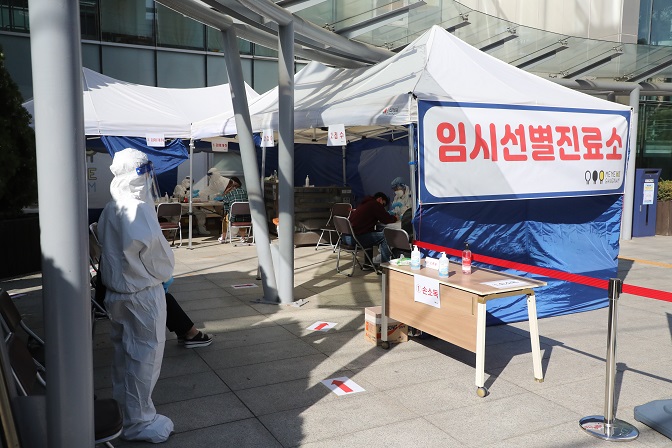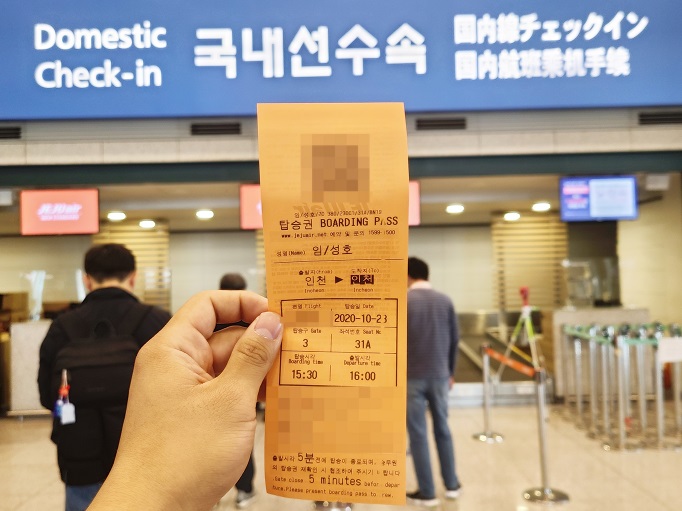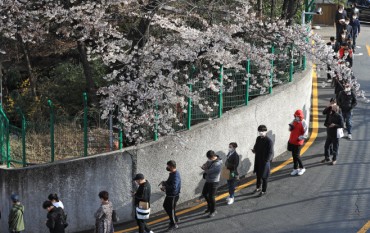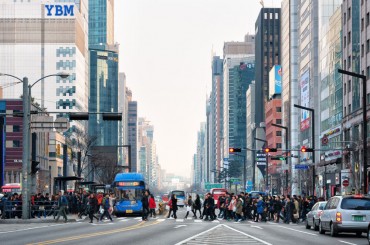
Residents are tested for COVID-19 at a temporary health clinic in southern Seoul on Oct. 23, 2020. (Yonhap)
SEOUL, Oct. 24 (Korea Bizwire) — South Korea’s new coronavirus cases returned to below 100 on Saturday after triple-digit infections were reported for the past two days, as sporadic cluster infections continued at senior care hospitals and other risk-prone facilities.
The country added 77 more COVID-19 cases, including 66 domestic infections, raising the total caseload to 25,775, according to the Korea Disease Control and Prevention Agency (KDCA).
New virus cases exceeded 100 for the past two days. Daily new cases came to 155 on Friday, marking the highest since Sept. 11 when the number hit 176.
The uptick was due to continued cluster infections at hospitals and facilities for the elderly, who are vulnerable to COVID-19.
The country’s new virus infections have been on a downward trend after a flare-up in the number of daily COVID-19 cases from mid-August to mid-September.
Compared with mid-August and early September when the tally rose by triple digits, the country has largely managed to slow the spread of the virus on the back of tougher social distancing measures.
Last week, the country relaxed its social distancing scheme to the lowest level in its three-tier system, after applying Level 2 measures across the nation since late August.
South Korea operates a three-tier social distancing system. Under the second level, indoor gatherings of more than 50 people are banned.
The government has not yet issued the highest alert, which bans gatherings of 10 or more people.
The Level 2 social distancing was in effect from late August through Oct. 11, while the Seoul metropolitan area was temporarily put under Level 2.5 during the period.
The country’s daily virus cases had been in the triple digits for more than a month since Aug. 14, due largely to a church in northern Seoul and an anti-government rally.
Under Level 1 measures, citizens are permitted to normalize most of their daily routines, with some infection prevention steps in place.
Even risk-prone facilities, including clubs and bars, are allowed to operate after monthslong suspension as long as they keep entry logs and follow sanitary measures.
But continued rises in sporadic cluster infections at facilities for senior citizens have become the biggest huddle in the country’s virus fight.
Health authorities urged people to thoroughly keep sanitary measures under the Level 1 virus curbs as cluster infections continue to rise at vulnerable facilities.
Kwon Joon-wook, deputy director of the Central Disease Control Headquarters, called on citizens to be vigilant, especially in the coming week through Halloween, which falls next Saturday.
“In particular, young adults and middle-aged people are required to not visit public facilities, such as karaoke, as the government has just controlled the number of virus cases at manageable levels,” Kwon said in a press briefing.
He said the authorities will also step up efforts to prevent the spread of imported cases as COVID-19 infections continue to rise in Europe and the United States.
The U.S. reported more than 80,000 new virus infections Friday — the highest daily case number since the pandemic began.

A customer holds up a Jeju Air Co.’s boarding ticket at Incheon International Airport, west of Seoul, on Oct. 23, 2020, for a special one-hour flight that departs from Incheon and returns to the airport as the carrier strives to survive the coronavirus crisis. (Yonhap)
Of the newly identified local infections, 22 cases were reported in Seoul, 32 cases in Gyeonggi Province that surrounds the capital and two cases in Incheon, west of Seoul.
The greater Seoul area is home to around half of the nation’s 51.6 million population.
Other municipalities reported new infections, with the country’s southwestern city of Daejeon adding five cases and South Chungcheong Province reporting five new cases.
The KDCA has warned that a resurgence in virus cases can happen anytime with sporadic outbreaks.
It remains on alert over the possibility that the coronavirus outbreak and a seasonal flu could be in full swing together in the winter.
Since July, South Korea has administered remdesivir, an experimental drug developed by Gilead Sciences Inc. and conventionally used to treat Ebola, to 671 patients here.
The country, meanwhile, added 11 imported cases, bringing the total to 3,627. Four cases came from the United States, followed by three from the Philippines, and one each from India, Indonesia, Iraq and Ukraine.
South Korea reported two additional deaths, raising the death toll to 457. The fatality rate was 1.77 percent.
The number of seriously or critically ill COVID-19 patients came to 60 as of midnight, down from 62 the previous day.
The total number of people released from quarantine after making full recoveries stood at 23,834, up 117 from the previous day.
The country has carried out 2,528,621 coronavirus tests since Jan. 3, including 12,058 tests from the previous day.
The pandemic, which started in China late last year, has killed more than 1.1 million people worldwide and infected more than 42 million as of Saturday, according to a tally from Johns Hopkins University.
(Yonhap)






